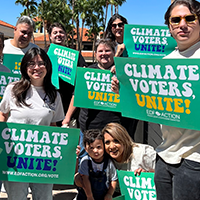Cities and states are declaring climate independence from Trump
 By Eric Pooley
By Eric Pooley
This blog originally appeared on EDF Voices.
Just as the federal government was truly accelerating on national climate action, Donald Trump took the wheel and tried to slam the car into reverse. But despite his best efforts to kill United States climate policies, there’s still enormous momentum propelling us forward.
What’s going on? Call it Climate Independence Day.
First, we can thank our Founding Fathers for a system of governance that gives fierce independence and real power and to our 50 states. Second, we can thank visionary leaders – from both parties – at the state and local level, who are using that power to chart their own course.
That‘s why, even though the federal government has begun pulling out of the Paris climate agreement, a vast majority of Americans, 70 percent, live in places that have proclaimed, “We Are Still In.”
It‘s why more than 550 legislators pledged meaningful climate action in 45 states last month, more than 300 mayorspromised to make their cities run 100 percent on renewables by 2035, and one state after another is now setting clean energy goals that far exceed anything we’ve seen before.
Will this groundswell of state and local action help the U.S meet its Paris targets? Perhaps not.
But it will keep us moving until climate realism returns to Washington – and it shows that far from throwing in the towel, America is stepping up and fighting back to protect policies that safeguard public health, our climate and our planet.
Why city and state actions actually matter
Let’s be clear: There’s no substitute for federal action on climate. We need to set national goals and to work with other countries to bring down emissions. It may not happen under Trump, but Trump is not forever.
In the meantime, city and state initiatives – along with measures some of our largest corporations are taking to cut carbon pollution – are especially crucial given federal inaction. Such actions:
- put in place policy solutions such as carbon markets that will secure necessary reduction now and offer a roadmap for ambitious federal action when the political winds change.
- help us reduce emissions now, rather than later, which has an important effect on warming in the long-run. Every pound of carbon we prevent today matters.
- help optimize decisions that are already being made today in the power sector and beyond, such as investments in smart grid technology and demand response solutions that save energy and reduce emissions going forward.
Americans are charting their own course
This momentum helps explain why, by the end of 2016, carbon pollution from U.S. power plants had already declined 25 percent below 2005 levels. It means the sector is already well on its way to meet targets spelled out under the Obama administration’s Clean Power Plan.
It helps explain why a state such as North Carolina withdrewits legal challenge of the Clean Power Plan in March 2017 after it had previously been a party to a 27-state lawsuit seeking to stop the federal rule. And why the Republican governor of Illinois recently signed legislation that will ramp up renewables and cut state power sector carbon pollution by 56 percent by 2030.
So far, 12 states accounting for 10 percent of emissions from our power sector have already pledged to uphold the goals set for the U.S. under Paris, openly bucking Trump’s policy. Several of those states were carried by Trump during the 2016 election.
The truth is, this presidency has – like never before – energized Americans and helped them understand that by protecting our climate, we’re also protecting public health, innovation and economic growth.
Governors, state legislators, mayors, city council members, business leaders and voters from across the political spectrum understand that by investing in clean energy and infrastructure upgrades that help cut emissions, we’re also betting on industries of the future and staying competitive. It means we’re trying out new ideas and staying optimistic.
What could possibly be more American?



